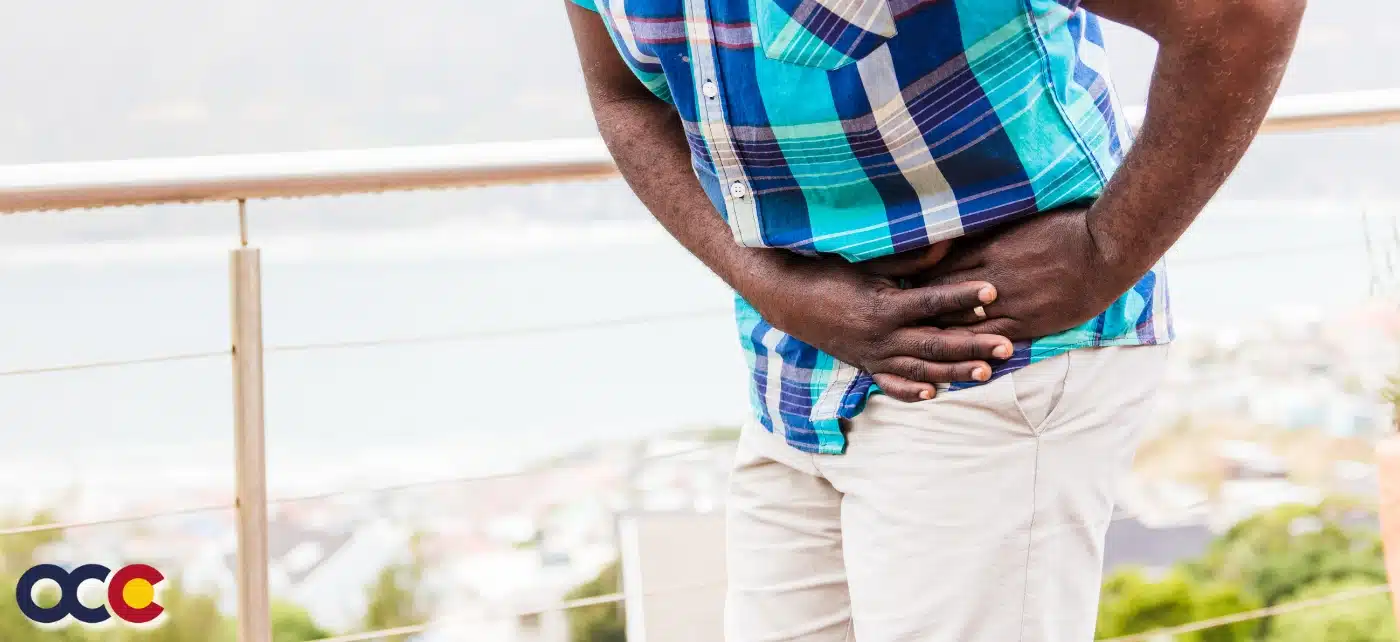Hip sprains can cause intense pain that can impact your daily activities and overall quality of life. It can limit your movements, preventing you from doing simple day-to-day activities like walking, sitting, or running. For athletes, it means you are out of the game or out of competition. The pain and subsequent compromised mobility with a hip sprain. may occur in other areas of the body, such as the leg, sciatica, groin, or spine. A hip strain may trigger the onset or progression of hip osteoarthritis. What sets apart a full recovery and the worsening of symptoms is how soon you get help for it. Injuries that don’t receive immediate treatment may take months to recover fully from and may also cause chronic ongoing pain. If you are experiencing hip pain you should consult immediately with the extensively trained and highly respected surgeons at OCC – Advanced Orthopedic & Sports Medicine Specialists in Denver, Parker, or Aurora, Colorado. That way you can be assured of getting the most comprehensive and successful treatment.
OVERVIEW
A hip strain can happen in the blink of an eye or gradually materialize from continuous wear and tear. People are often confused between the terms “strain”, and “sprain. The difference between a hip strain and a hip sprain is the type of tissue that is damaged. Simply put, a hip strain occurs when a tendon or muscle in the hip is stretched, torn, or damaged. A sprain occurs when a ligament is stretched, torn, or damaged. While hip strains can occur quite commonly, hip sprains are very rare. A hip strain may be a simple stretch in the muscle or tendon, or it may be a partial or complete tear of muscle fibers or the muscle and tendon combination. The most common muscle strain on the hip is the hip flexor strain. The hip flexors are a group of muscles that allow one to bend the hip and bring the leg up toward the body. This type of strain is often caused by overuse or sudden movements and can be very painful.
ABOUT THE HIP JOINT
The hip joint is the connection point between the legs and torso. It is one of the largest joints in the body after the knee. The hip joint is considered a “ball and socket” joint. The “ball” is known anatomically as the femoral head; the “socket” is part of the pelvis known as the acetabulum. The ball-and-socket joint allows for a wide range of motion and provides support for the legs to hold the body. Several components make up the hip joint:
- Bones—the hip joint connects the thigh and hip bones
- Cartilage—a smooth substance that covers the femoral head and acetabulum socket acting as a cushion that absorbs impact when walking or moving
- Synovium—a thin cover that wraps around bones making a fluid that provides lubrication so bones can move easily without resistance
- Bursa—a fluid-filled sac that provides cushioning and a smooth surface for bones, muscles, and tendons to move on
- Ligaments—fibrous bands of tissue that connect bones to bones
- Tendons—fibrous bands of tissue that connect muscles to bones
- Muscle—muscles support the joint and help movement. Hip muscles include gluteals, adductor muscles, iliopsoas muscles, quadriceps, and hamstrings.
WHAT IS HIP STRAIN?
A hip strain is when the muscles or tendons around the hip joint get stretched too far or torn. Hip strains frequently occur near the point where the muscle joins the connective tissue of the tendon. The most common mechanism of injury for hip strains is when a stretched muscle is forced to contract suddenly such as from twisting awkwardly or overexerting during exercise. A fall, overstretching, or a direct blow to the muscle can all tear muscle fibers, resulting in a strain. Hip strains are also caused by overuse such as when the muscle or tendon has slowly become weakened over time by repetitive movements. There’s no difference between a strained muscle and a pulled muscle. People use the terms interchangeably. The same is true for a strained muscle and a torn muscle. They’re the same injury with the same symptoms and treatments.
WHAT IS A HIP FLEXOR STRAIN?
A hip flexor strain is a specific type of hip strain. While “hip strain” can refer to any injury involving the hip area, a hip flexor strain occurs when the muscles and tendons attached to the pelvic bone are injured. A hip flexor muscle is a muscle that functions in flexing the hip, for example, bringing the knee closer to the chest. Every time one takes a step, they are using their hip flexor muscles. A hip flexor strain may be a partial or a full tear of any or all of the hip flexor muscles. A hip flexor strain is graded from 1 to 3:
- Grade I tear: a minor tear, in which only a few fibers are damaged
- Grade II: a significant number of muscle fibers are damaged and there is a moderate loss of hip flexor function
- Grade III: the muscle is completely ruptured or torn and usually results in being unable to walk without a limp
CAUSES
Hip strains are caused by many risk factors and activities:
- Prior injury in the same area
- Running
- Kicking such as in football or soccer
- Hockey
- Martial arts
- Cyclists
- Dancers
- Lifting heavy objects
- Poor flexibility
- Inadequate warm-up before exercise
- Muscle tightness or weakness
- Trauma such as falls or car accidents
- Seniors
- Being overweight
- A misstep on an uneven surface
Even with everyday activities, anyone can suffer from a hip strain.
SYMPTOMS
The primary symptom of hip strain is a dull discomfort over the affected area, which worsens when one attempts to use the hips more forceably. However, multiple symptoms can present, based on the severity of the injury:
- A sudden “pop” feeling in the front of the hip at the time of injury
- Discomfort when pressure is applied
- Tenderness
- Stiffness
- Muscle spasms
- Pain ranging from mild to severe that can become chronic
- Swelling
- Limited range of motion
- Bruising in front of thigh and hip typically shows up within 48 hours of injury
- Cramping
- Difficulty getting out of a chair or coming up from a squat
- Difficulty climbing stairs or walking up or down sloped surfaces
- The top of the thigh muscle may bulge
NON-SURGICAL TREATMENTS
- Mild strains can be treated with the RICE protocol. RICE stands for rest, ice, compression, and elevation.
- Nonsteroidal anti-inflammatory drugs, or NSAIDs, such as ibuprofen and naproxen, can help reduce swelling and relieve pain.
- Crutches may be recommended for a few days to limit weight on the hip.
- Home exercise can strengthen muscles that support the hip and help to improve muscle endurance and flexibility.
- A qualified physical therapist is a good tool for conservative treatment of more intense hip strain. Physical therapy can encompass various forms of treatment, such as massage, therapeutic ultrasound, heat therapy, and more intense strengthening exercises.
WHEN IS SURGERY INDICATED?
Most hip strains can be treated without surgery. For a severe (grade III) strain, surgery may be required to repair the torn muscle. If the strain is severe enough to pull tendons off the bones, surgery typically involves re-attaching the torn tendon tissue back to the bone. A surgeon will discuss which type of surgery is needed and what to expect.
GETTING THE RIGHT DIAGNOSIS. GETTING THE RIGHT DOCTOR.
Many injuries cause muscle pain similar to hip strains including pinched nerves, herniated disks, hip impingement, blood clots, and other muscle strains, like groin and quadriceps strains. A wrong diagnosis can cause irreparable harm. This is why it is imperative to get a thorough and exacting diagnosis from a surgeon extensively experienced in treating hip strains. At Advanced Orthopedics in Denver, Parker, or Aurora, Colorado, their surgeons are foremost in their field and known for their outstanding results. An in-depth physical examination is critical to determine which activities may have triggered the injury and ensuing symptoms. Because of the potential complications of a wrong diagnosis, imaging, including X-rays and MRIs may be ordered to help pinpoint the injury and its severity. Interpreting all the information allows your doctor to create a personalized treatment plan. The capable and accomplished surgeons at Advanced Orthopedics know exactly what to do to get you off the bench, or just back onto your feet, back to doing what you need to do and want to do to make the most of your life. Schedule an appointment with Advanced Orthopedic if you are experiencing hip pain.













